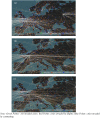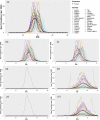Identification of critical airports for controlling global infectious disease outbreaks: Stress-tests focusing in Europe
- PMID: 32501381
- PMCID: PMC7151290
- DOI: 10.1016/j.jairtraman.2020.101819
Identification of critical airports for controlling global infectious disease outbreaks: Stress-tests focusing in Europe
Abstract
As the global population increases and transportation connectivity improves in quality and prices, the demand for mobility increases, especially in long-haul services. According to the 2017 report of the European Commission in Mobility and Transport, the performance of all modes for passenger transport (roadways and airways) are reaching record highs. Although the benefits of the increased demand for mobility are substantial and welcome, an effort should be paid such as to ameliorate possible threatening side-effects that may also arise. As World Health Organization (WHO) denotes and as has been evident from the global COVID-19 epidemic outbreak, infectious diseases can be spread directly or indirectly from one person to another under common exposure circumstances such as air transportation (especially long-haul airline connections) that may act as the medium for transmitting and spreading infectious diseases. In this paper, analytical and realistic models have been integrated, for providing evidence on the spread dynamics of infectious diseases that may face Europe through the airlines system. In particular, a detailed epidemiological model has been integrated with the airlines' and land transport network, able to simulate the epidemic spread of infectious diseases originated from distant locations. Additionally, a wide set of experiments and simulations have been conducted, providing results from detailed stress-tests covering both mild as well as aggressive cases of epidemic spreading scenarios. The results provide convincing evidence on the effectiveness that the European airports' system offer in controlling the emergence of epidemics, but also on the time and extent that controlling measures should be taken in order to break the chain of infections in realistic cases.
Keywords: Airlines' network; Epidemics modelling; European airports' security; Infectious diseases spreading.
© 2020 Elsevier Ltd. All rights reserved.
Figures
















References
-
- Angeloudis P., Fisk D. Large subway systems as complex networks. Phys. Stat. Mech. Appl. 2006;367:553–558. Matamalas, Arenas and Gómez, 2018.
-
- Balcan D., Hu H., Goncalves B., Bajardi P., Poletto C., Ramasco J., Paoletti D., Perra N., Tizzoni M., Van den Broeck W., Colizza V., Vespignani A. Seasonal transmission potential and activity peaks of the new influenza A(H1N1): a Monte Carlo likelihood analysis based on human mobility. BMC Med. 2009;7(1) - PMC - PubMed
-
- Barabási L.-A. first ed. Cambridge University Press; 2016. Network Science.
-
- Berman O., Gavious A., Menezes M. Optimal response against bioterror attack on airport terminal. Eur. J. Oper. Res. 2012;219(2):415–424.
LinkOut - more resources
Full Text Sources
Research Materials
